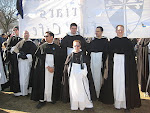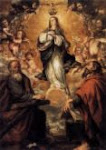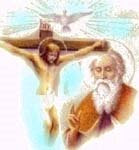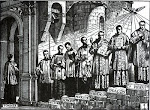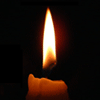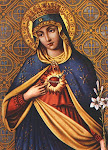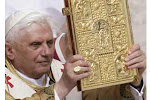

Original Version of Habit, such as it would have been at St Kynemark's at the Reformation.
Thanks Tad Allan!
Restoration of a site and Augustinian Canons, such as there would have been at St Cynfarch's wear this habit. Thank you to Stephen Webb for the tip about the habits! It is also easy to see why some thought this Abbey to be Premontensian!as the habits are similar perhaps.Augustinian Canons were also at Llanthony Priory, prima and secunda.
Yesterday we learned that the location of this priory (of which there are now few signs) has been excavated and a paper by L.A.S Butler published. What was puzzling, when the excavations happened was that the Church of St John the Baptist are not part of the priory, which was a small one, and possibly of the scale of the little Penmon Priory and that of the church at Peterstone. The monastery seems to have been simple in design, although pieces of decoration on the interior of the stone walls , were colour washed in pink and then in white, with imitation stone pattern picked out in red lines and a trailing leaf patterns added in green rock floors had been made smooth by layers of sand and mixed with soil and covered with rushes.In the diagram above, it is important to realise there were more buildings to the south and all was enclosed in a boundary wall, which may have been originally a circular shape, adapted to a more rectangular shape in Norman times.
St Kynemarks lies nest to the ridge at Crossway Green one mile north of the church on the road to Tintern and Monmouth.Post Mediaeval spelling was Kinmark or Kingsmark.
Destruction of the Llandaff Records
The religious house at St Kynemarks may originally have been ancient and royal, but was quite small in size and its possessions were all local, so the house is not mentioned much in the records. The Mediaeval books were destroyed when Llandaff was sacked and ruined by Owain Glyn Dwr and again by robbers and brigands from Bristol. The records of many houses literally disappeared during these times. However the Book of Llandaff does contain references to Arthrwys, King of Gwent, who gave the Church of St Cynfarch to the see of Llandaff early in the seventh century. The church of St Arvans in a tenth century gift also came to Llandaff in a papal Bull of 1128-the year of the canonisation of St David of Wales by Pope Calixtus II .Porthcaseg Church, another local church and the two other churches were also confirmed to the see of Llandaff in this Bull of Pope Honorius II but may have just confirmed what was Llandaff’s . The Church of St John Baptist seems to have disappeared.
St Cynfarch, disciple of Dyfrig/Dubricius giving Llandaff its claim
We know it existed four or five centuries before Chepstow Priory was built by the Normans, and is the church to which the inhabitants of Chepstow would have resorted. The first mention of it is when Arthrwys ,King of Gwent granted this church-ecclesiam cynfarchi with others to Comereg one of the assistant bishops to Teilo in the sixth century. I was also one of those churches confirmed by Pope Honorious II to Bishop Urban (1108-1133) and the see of Llandaff, where it is described as Villa Lanncinnmarch cum Prato.
Augustinian Canons fomed from Celtic 'Llans'
The Augustinian Priory was founded here in the eleventh century, when the priory was probably reorganised from a former Welsh Celtic style llan. I have already shown why the Celtic foundations would have chosen the Augustinian charism after the style of Anthony of the Desert. In the Norwich Valuation the Church of St Kennemarco is described as a Chapter Property and assessed by one mark. In the mid thirteenth century Butler says that the church at Striguil(Chepstow) is included and also the chapels of Porthcaseg and St Arvans, both dependent chapels served by St Kinmark’s;the omission of St Kinmark’s implies it still belonged to Llandaff.
The Wentwood Dispte over Hay, House and Fire-bote (-boot)
Throughout the Middle Ages Llandaff kept an interest in St Kynemarks . In 1270 St Kynemark is presented in the survey of Wentwood –that the Prior and monks of St Kynemarks ought to have Hay and House boot in Wentwood. The Prior of Tintern, of Chepstow and St Kynemarks all attended the court to dispute the hay and house bote.Others present were Robert son of Pagan of Llanfair Uchoed, William Blewitt (who ‘ought to have hay and house bote in Wentwood by right of conquest’,William Denford de Cricke,Richard de Moor and Bartholomew de Moor , Knight,Robert de Moor, John Martyll Mathew Deband of Portskewett, William de St Maure of the manor at Penhow, and manyothers. Wentwood, called in Welsh Coed Gwent, was the largest forest in the vicinity and was much larger than it is today, extending to Chepstow Park. This is borne out by occasional ‘assarts’ that is references to land reclaimed from woodland. The lords of all the manors holding under the lordship of Chepstow had rights in Wentwood to cut timber to build houses called ‘house boot’, hay boot was the right to cut brushwood (called tinnet nowadays) for making fences; and though not mentioned in the lists of lords of the manors , fireboot was the right to cut certain woods for fuel’.The owners of the various rights to the boots kept these until about 1630.
Inquest into the Death of Roger Bigod
At the inquest into the death of Roger Bigod , Earl of Norfolk and Lord of Striguil in 1306, the Prior of St Kinmark’s is listed among the free tenants and pays rents on two tenements at Chepstow.
Prior William Hennyg of St Kynemark in court to prove a title
Butler also lists the 1415 Court Case, where Father William Hennyng, Prior of St Kynemarks , produced as a title to his land which the priory held in the lordship , a grant held by an earlier lord Gilbert Marshall, Earl of Pembroke (1234-1241)the fact that the document which was roduced was a confirmation and not the original deed could, says Butler imply that the priory was of considerable antiquity, possibly even of Celtic origin.
Augustinian Devotion to St John Baptist
In 1355 it appeared as St John the Baptist Church, no surprise because St John Baptist was himself a hermit and a favourite saint of the Augustinians. On 13th of August 1355 . Richard de Tuddenham, a canon who for some nefarious reason was in monastic prison cell and broke out and fled. Pope Bonifcace IX gave a mandate for him to reconcile to his Order. In fact he was often incarcerated and often escaped, but clearly had something about him that they kept taking him back.
By 1603, however St Kynemark’s is no longer mentioned but there is a record of a Chepstow parish register records the baptism of Eleanor, daughter of Walter Hutton at St Kynemark;s in 1642, so the church was still in use at this time. The location of the land of St Kynemark’s are no longer clear. Some of them belonged to William Lewis of St Pierre (‘caires in St Kynemark’, St Lawrence in Chepstow held of the Earl of Wigorn and the Bishop of Llandaff) So it seems Llandaff still had kept some of the lands.
Crossgreen Farm stolen by Roundheads in 1648
In 1648 it seems that Cross green Farm was among the posessions of Llandaff stolen by parliament. This farm is outside the present parish of St Kynemarks and was in St Arvan’s parish. As for the lack of a church on the site, what of the ancient tower in Piercefield Park? Bradney writes of the tower in the park :’A feature in the park is a tower now nearly a ruin of whose history no record remains. Parts of it are very ancient especially the doorway. Around are signs of buildings . From under the door there runs for about 20 yards an underground passageway along which a man could crawl and around are signs of buildings. It stands on the Roman Road about a mile from Crossway Green and is marked on the plan of piercefield by Archdeacon Coxe in 1801 as ‘Grove House’?Bradney:Hundred of Caldicot p 40. Question is as the model army wnt around destroying beautiful churches-did they also destroy the church of StJohn the Baptist and only leave the tower? Or what of St Lawrence's?
Pope Nicholas' Taxation 1291
Financially the Priory was assessed at £1 16s 1d from the assessment from Abergavenny Priory of the tenth or the total income of St Kynemark.. In Pope Nicholas’ taxation of 1291 the priory held land and estates in Langstone, Striguil/Chepstow, Stowere and St Kynemark to a total value of £7.2s 10d and also held the rectories of St Kynemarks, St Arvans and Porcasseg. This last assessment, says Butler, shows the small scale of the Abbey and number of monks was probably quite small.
Brother John ap Howell presented for Ordination at Hereford 1531, just before the Henrican Holocaust.
In 1531, John ap Howell was presented for ordination in the diocese of Hereford by the Prior of St John’s Monastery by St Kinmark and proceeds by way of acolyte and subdeacon to the order of priesthood.
Financial Difficulties
In 1492, the Prior could not pay the annual pension of 13/4d to the monastery of St Augustine, Bristol (seemingly the Mother House) and five years later they were still in arrears.The pension was supposed to net £46 over sixty years and the terminal date was in 1527-8. Possibly the payments would have started as larger payments in 1458.
The Lease of the Earls of Worcester
Butler also gives details of a lease of 1529, shortly before the seizure of the priories. Father John Pynnock, the Prior St Kynemark and the Convent of that place leased to William David ap Richarda cottage in Chepstow earlier rented by John Fyer and Maragaret his wife. The priory seal is attached to the leasewhich is dated in the Chapter House of the Priory.
After the seizure and destruction of most of the monasteries, most of their lands and possessions went to the Earls of Worcester. The Somerset family had been stewards of the two larger monasteries , but it is less likely that they bothered with St Kynemark’s. In fact they may well have remained there until they died, since the Earl of Worcester ‘s son was a Catholic , received recusant priests into his castle at Raglan and was generally well disposed towards clergy, although clergy in England were hunted more assiduously.
Willis Bund describes St Kynemark as Norbertine or Premontensian, but the Priory existed for three centuries and there are no records, and it may be that negotiations were underway to perhaps share the Priory with Norbertines.
However we know for certain that Tuddenham the apostate was an Augustinian Canon. Possibly the Priory was formed from the well established house of Roger de Bereceroles of Bristol or possibly Llanthony. Still there must have been some reason for the Catholic Encyclopaedia calling it Premontensian, but it is useless to speculate, although there may have been some sharing perhaps a younger order taking over from an ageing one. The documentary evidence is very slight because most of the records were destroyed at Llandaff and its holdings and rectories were not part of Herefordshire or Worcester or Bath and Wells. The only direct link there is ,is of the earls of Worcester being given the lease of 1529 ,which must have been part of the monastic deeds of the Earls of Worcester such as Tintern Abbey and Chepstow Priory and many of those were destroyed when during the Civil War, Raglan Castle itself was destroyed and burnt out. The Earls did possess St Arvans and St Kinmarks as seen in one of the few surviving deeds at Badminton MSS in the Tintern Court Rolls.
Difficulties with the site of the Priory
The exact location of the monastery and its compass has yet to be decided. It is not clear, whether the Priory of John the Baptist and the Church of St Kinmark were adjacent as appears to have been the case elsewhere, or whether the two buildings were apart. As the house was so small, it may even have been that a small chapel or oratory was housed in the East Range as so often the case in today’s Abbeys, so that the monks served their church as a parish church.Butler says ‘the elevated position is unusual for a monastery of early foundation , when compared with the secluded position of Llancarfan, Llantwit Major for example but would not be remarkable for a parish church. In 1840 an archaeologist called Nicholson stated that the stone walls around St Kynemark’s farm were a remnant of the priory, and David Williams in 1796 stated it was at the Turnpike on the road from Chepstow to Tintern. An excavation in 1962 and 1963 found the foundations of two buildings within the farmyard with their exis being North to South and a cemetery with at least 17 burials in rock cut graves. L.A.S Butler does say that far more work is to be done here. It seems the farmhouse itself may have served as the south range of the Abbey, only more research will tell, since the relationship between the bishopric and the Augustinian Priory needs to be understood more clearly, and with documentary evidence lacking only archaeology and the practices of the Augustinians can give us information.
Everyday Life
My drawing at the top (and I am no artist) is meant to show how it may have looked. We know it was stone built, possibly rendered and lime washed as was typical of the time. I have shown chickens being kept, bees, vegetables etc but no doubt they brought in other meats and had a farm close by where they could get milk and other things. There was a mill at Tintern and possibly even closer at Trellech , where they could buy in what they needed.
Fishing-Prior's Weir, Prior's Reach
The subsequent history of the priory seems to have been one of decay as locals robbed the stone. It is also clear from Mr Butler’s excavations even the stone from the foundations was taken, which has made life difficult and introduced more speculation. Finally, no doubt the Black Death in the 14th century made life a great deal harder, for the maintenance of the buildings and work in the fields. People could not pay tithes if they were ill or dead and as in so many places, perhaps the vocations dwindled as people made for the towns. There was also the fact that the Crown itself during the time of Henry VIII imposed always greater taxes on religious houses to deliberately bring them down. St Kynemark’s had valuable fishing rights on the Wye. Records of Lancaut Church show the name of the Prior’s Weir. A man described as the farmer of the Prior of St Kynemark’s weir who was involved in a tithe dispute was presumably holding the weir at Lancaut which with a weir-house was among the former possessions of St. Kynemark's Priory, in 1577; it was probably Liveoaks Troughs Weir which lies just below a stretch of the river known as ‘Prior's Reach.’
It is, however, important to remember and commemorate the work of prayer of the Augustinian Canons, who laboured there in their desert from the time of Dyfrig (Dubricius). A life spent in prayer of the Liturgy of the Hours, Physical work, frugal meals, service to the Community as they served the people of Chepstow as priests of St Lawrence and St Kynemark. The Chepstow Priory Church in later times became a parish church even before the Reformation, but St Kynemark’s was a small fairly unimportant house, but a home for people who made a big difference to the people around them. The religious brothers, who even in the world today improve the quality for the people, helping their disputes and acting as Christ in our midst. Though not all of them were perfect, most devoted their whole lives to their vocation and the seventeen stone coffins no doubt contained their mortal remains.
The house was never worth much and seemed to be in financial trouble for its last 50 years, so not much was done with it, except to lease it out to local farms, when anything valuable had been sold off and yet there is othing recorded in the Monasticon, so the brothers obviously dd live simply and poorly, as they do today.
_____________________________________________________________________________________
Augustinian Canons today
The spirit of St Augustine is alive and well and all over the world. It is the building which has vanished.
The spirituality of the Brothers at Llanthony,St Kynemark's and Peterstone can be seen in this novena by the Augustinian Bishop of Manila:
+In nomine Patris, filio et Spiritui sancto.
Dear Brothers,
With St. Augustine we say ,You have made us for Yourself O Lord, for you alone our God, and our hearts are restless until they rest in you.
As we begin our novena to our Father St. Augustine we pray for the grace to make his spirit our own, on our journey towards our inner self. We reflect on who we are and where we are going as Augustinian Religious and devotees in the context of our time. Move by the spirit of Augustine’s restless pursuit for truth.
What motivates me to continue searching for God?
Having found Him, how do I make Him alive in my relations to people with whom I live?
If there is one thing that Augustinian emphasizes over and over again in treating of the search of God, it is that we must begin by going with ourselves. The keyword is WITHIN. There will find truth, light, joy in Christ Himself.
There we will be heard when we pray; there we will love and worship God. But while this within signifies the very depths of our being, this is only the first stage of the journey. Augustine urges us to keep moving on even to what is beyond ourselves, to the source of our inspiration and light to God Himself.
Augustine would tell us, “Do not go outside yourself, but turn back within. Truth dwells in the inner man; and if you find your nature given to frequent change, go beyond yourself. Move on, then to that source where the light of reason itself receives its light.. (End of the reading – Some moments of silence)
LITANY IN HONOUR OF SAINT AUGUSTINE
Lord, have mercy on Lord, have mercy on us
Christ, have mercy on us Christ have mercy on us God the Father of Heaven Have mercy on us
God the Son, Redeemer of the World Have mercy on us World God, the Holy Spirit Have mercy on us
Holy Trinity,One God
Have mercy on us
Mary,MotherofJesus
Pray for us Mary, Mother of Consolation Pray for us
Mary, Mother of Good Counsel Pray for us
St. Augustine, bright star of the Church Pray for us
St. Augustine, filled with zeal for God’s glory Pray for us
St. Augustine, dauntless defender of the truth Pray for us
St. Augustine, the triumph of divine grace Pray for us
St. Augustine, on fire with the love of God Pray for us
St. Augustine, so great and so humble Pray for us
St. Augustine, prince of bishops and doctors Pray for us
St. Augustine, father of monastic life. Pray for us
St. Augustine, holiest of the wise and wisest of the holy Pray for us
Pray for us St. Augustine, That may become worthy of the promises of Christ.
ALL: You have made for yourself O Lord, and our hearts are restless until they rest in you. We ask you to bless our restlessness in our search for you will live in our lives, and in the events confronting us.
Finding you, may we be faithful to you God of history, faithful to Christ our Lord and Saviour, faithful to the Church and her teaching and faithful to our particular state of life, which we have chosen to serve you. This we ask of you loving Father, through Christ our Lord and through the intercession of Saint Augustine, our Father.
Amen.




